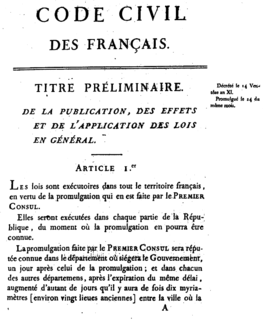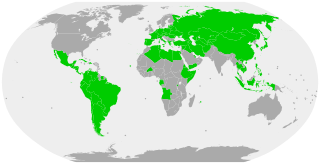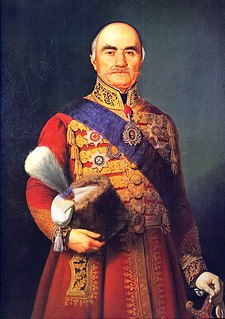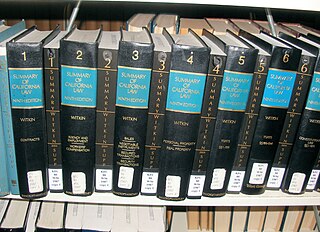
Roman law is the legal system of ancient Rome, including the legal developments spanning over a thousand years of jurisprudence, from the Twelve Tables, to the Corpus Juris Civilis ordered by Eastern Roman Emperor Justinian I. Roman law forms the basic framework for civil law, the most widely used legal system today, and the terms are sometimes used synonymously. The historical importance of Roman law is reflected by the continued use of Latin legal terminology in many legal systems influenced by it, including common law.

The Napoleonic Code (French: Code Napoléon; officially Code civil des Français, referred to as Code civil) is the French civil code established under Napoleon I in 1804.

A civil code is a systematic collection of laws designed to deal with the core areas of private law such as for dealing with business and negligence lawsuits and practices. A jurisdiction that has a civil code generally also has a code of civil procedure. In some jurisdictions with a civil code, a number of the core areas of private law that would otherwise typically be codified in a civil code may instead be codified in a commercial code.
Legal history or the history of law is the study of how law has evolved and why it changed. Legal history is closely connected to the development of civilisations and is set in the wider context of social history. Among certain jurists and historians of legal process, it has been seen as the recording of the evolution of laws and the technical explanation of how these laws have evolved with the view of better understanding the origins of various legal concepts; some consider it a branch of intellectual history. Twentieth century historians have viewed legal history in a more contextualised manner more in line with the thinking of social historians. They have looked at legal institutions as complex systems of rules, players and symbols and have seen these elements interact with society to change, adapt, resist or promote certain aspects of civil society. Such legal historians have tended to analyse case histories from the parameters of social science inquiry, using statistical methods, analysing class distinctions among litigants, petitioners and other players in various legal processes. By analysing case outcomes, transaction costs, number of settled cases they have begun an analysis of legal institutions, practices, procedures and briefs that give us a more complex picture of law and society than the study of jurisprudence, case law and civil codes can achieve.
The Bürgerliches Gesetzbuch, abbreviated BGB, is the civil code of Germany. In development since 1881, it became effective on January 1, 1900, and was considered a massive and groundbreaking project.
In the United States, state law refers to the law of each separate U.S. state.

Miloš Obrenović born Miloš Teodorović was Prince of Serbia from 1815 to 1839, and again from 1858 to 1860. He participated in the First Serbian Uprising, led Serbs in the Second Serbian Uprising, and founded the House of Obrenović. Under his rule, Serbia became an autonomous principality within the Ottoman Empire. Prince Miloš ruled autocratically, permanently refusing to share power. During his rule, he was the richest man in Serbia and one of the richest in the Balkans.
Civil law, or civilian law, is a legal system originating in Europe, intellectualized within the framework of Roman law, the main feature of which is that its core principles are codified into a referable system which serves as the primary source of law. This can be contrasted with common law systems, the intellectual framework of which comes from judge-made decisional law, and gives precedential authority to prior court decisions, on the principle that it is unfair to treat similar facts differently on different occasions.

The origin of the current law of the People's Republic of China can be traced back to the period of the early 1930s, during the establishment of the Chinese Soviet Republic. In 1931 the first supreme court was established. Though the contemporary legal system and laws have no direct links to traditional Chinese law, their impact and influence of historical norms still exist.
The Law of Germany, that being the modern German legal system, is a system of civil law which is founded on the principles laid out by the Basic Law for the Federal Republic of Germany, though many of the most important laws, for example most regulations of the civil code were developed prior to the 1949 constitution. It is composed of public law, which regulates the relations between a citizen/person and the state or two bodies of the state and the private law (Privatrecht) which regulates the relations between two people or companies. It has been subject to a wide array of influences from Roman law, such as the Corpus Juris Civilis, to Napoleonic law, such as the Napoleonic Code.

The Civil Code of the Philippines is the product of the codification of private law in the Philippines. It is the general law that governs family and property relations in the Philippines. It was enacted in 1950, and remains in force to date with some significant amendments.

The law of California consists of several levels, including constitutional, statutory, and regulatory law, as well as case law. The California Codes form the general statutory law.
The Burgerlijk Wetboek is the Civil Code of the Netherlands. Early versions were largely based on the Napoleonic Code. The Dutch Civil Code was substantively reformed in 1992. The Code deals with the rights of natural persons, legal persons, patrimony and succession. It also sets out the law of property, obligations and contracts, and conflict of laws. Proposed amendments will add a Book on intellectual property. The codification of laws is still being used in Indonesia as a pinnacle of the private laws besides Sharia law and custom laws. The laws initially applied only to Dutch settlers and foreign traders such as Chinese traders, Indian traders and Arab traders during the Dutch colonial era in Dutch East Indies, but after the independence of Indonesia in 1945, the government decided to retain the old Dutch law, expanded in use to indigenous people and Moslems voluntarily. The 1992 reformed version does not apply in Indonesia.
The Serbian Progressive Party was a conservative liberal political party in Serbia that existed from 1881 to 1919.
Bangladesh is part of the common law jurisdiction. It is a member of the Commonwealth of Nations. The legal system of Bangladesh has its roots in the laws of British India. Since independence in 1971, statutory law enacted by the Parliament of Bangladesh has been the primary form of legislation. Judge made law continues to be significant in areas such as constitutional law. Unlike in other common law countries, the Supreme Court of Bangladesh has the power to not only interpret laws made by the parliament, but to also declare them null and void and to enforce fundamental rights of the citizens. The Bangladesh Code includes a compilation of all laws since 1836. The vast majority of Bangladeshi laws are in English. But most laws adopted after 1987 are in Bengali. Family law is intertwined with religious law. Bangladesh has significant international law obligations.

The judicial system of Bhutan is the purview of the Royal Court of Justice, the judicial branch of the government of Bhutan under the Constitution of 2008. The judicial system comprises the Judicial Commission, the courts, the police, the penal code, and regulations on jabmi (attorneys).

Dimitrije "Mita" Davidović was a secretary to Miloš Obrenović I, Prince of Serbia, Minister of Education of the Principality of Serbia, writer, philosopher, journalist, publisher, historian, diplomatist, and founder of modern Serbian journalism and publishing.














